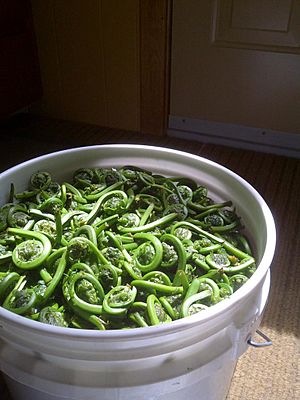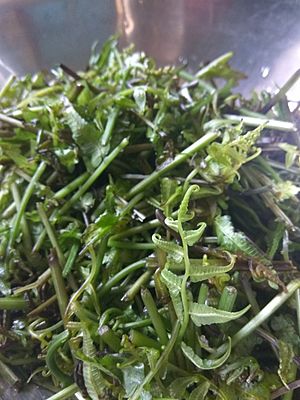Fiddlehead facts for kids
Fiddleheads, also known as fiddlehead greens, are the young, curled leaves of a fern plant. People pick them when they are still tightly rolled up, before they open into full leaves. They are eaten as a vegetable.
If a fiddlehead is left on the plant, it will slowly unroll into a new fern leaf. This unrolling process is called circinate vernation. Fiddleheads are harvested early in the spring, so they are cut close to the ground.
Fiddleheads are good for you! They have things called antioxidants, which help protect your body. They also contain healthy fats like omega-3 and omega-6, and they are rich in iron and fiber. However, it's important to know that some types of fiddleheads can be harmful if not cooked properly.
The name "fiddlehead" comes from how they look. They resemble the curled end of a stringed instrument, like a fiddle. They are also sometimes called a "crozier," which is the name for the curved staff that bishops use. This staff looks like a shepherd's crook.
Contents
Types of Fiddleheads We Eat
The young, curled leaves of certain ferns are eaten as a cooked green vegetable. Here are some of the most popular types:
- Bracken (Pteridium aquilinum): This fern is found all over the world. It must be cooked very well, as it can be harmful if not fully prepared.
- Ostrich fern (Matteuccia struthiopteris): Found in northern parts of the world, including North America. This type is very popular to eat.
- Lady fern (Athyrium filix-femina): Grows across most of the northern half of the world where the weather is mild.
- Cinnamon fern (Osmunda cinnamomea): Found in eastern North America. It's not as tasty as the ostrich fern.
- Royal fern (Osmunda regalis): This fern is found worldwide.
- Midin (Stenochlaena palustris): Found in Sarawak, where it is a special local food.
- Zenmai or flowering fern (Osmunda japonica): Found in East Asia.
- Vegetable fern (Athyrium esculentum): Found across Asia and Oceania.
Because fiddleheads are not always easy to find, especially in places where they don't grow naturally, they can be quite expensive.
Finding and Picking Fiddleheads
Fiddleheads are available only for a short time in the spring. People either go out and pick them from the wild (this is called foraging) or buy them from farms that grow them.
When picking fiddleheads, it's important to only take about one-third of the curled tops from each plant or group of plants. This helps make sure the fern can keep growing and producing more fiddleheads in the future. If too many are picked from one plant, it can die. Taking care of wild food sources is important so they can continue to grow for years to come.
Cooking with Fiddleheads
Fiddleheads have been a part of traditional meals for a long time. People in northern France have eaten them since the Middle Ages. They are also a traditional food in Asia and among Native Americans. In the Russian Far East, people often pick them in the autumn, preserve them in salt for winter, and then eat them in the spring.
Asian Cooking Styles
In Indonesia, young fiddlehead ferns are cooked in a rich coconut sauce. This sauce is spiced with chili pepper, ginger-like galangal, lemongrass, turmeric leaves, and other spices. This dish is called gulai pakis or gulai paku.
In the Philippines, young fern fronds called pakô are a special treat. They are often made into a salad with tomatoes, slices of salted duck egg, and a simple dressing.
In East Asia, bracken fiddleheads (Pteridium aquilinum) are a common vegetable. They are called kogomi in Japan, gosari in Korea, and juécài in China and Taiwan. In Korea, a common side dish called gosari-namul is made from prepared fernbrake fiddleheads that have been lightly fried. It's also an ingredient in popular dishes like bibimbap and yukgaejang.
In Japan, bracken fiddleheads are highly valued. Roasting them is believed to help remove any natural toxins. Japanese people also commonly eat fiddleheads from the flowering fern (Osmunda japonica), called zenmai, and the ostrich fern (Matteuccia struthiopteris), called kogomi, in springtime. Fiddleheads in Japan are considered sansai, which means wild vegetables. They are also used to make warabimochi, a Japanese dessert.
Indian Cooking Styles
In the Himalayan regions of North and Northeast India, fiddleheads are also found. In Tripura, they are known as Muikhonchok. They are stir-fried as a side dish called bhaja. In Himachal Pradesh, they are called Lingad or lingri and are used to make a pickle called lingri ka achaar. In the Kangra Valley, they are called lungdu and eaten as a vegetable. In Chamba, they are known as "Kasrod." In Uttarakhand, they are called limbra or languda and eaten as a vegetable.
In Darjeeling and Sikkim, they are called niyuro. They are a common vegetable side dish, often mixed with local cheese, and sometimes pickled. In Assam, they are known as dhekia xak and are a popular side dish. In Jammu and Kashmir, they are called kasrod. A famous dish is kasrod ka achaar (fiddlehead fern pickle). In Poonch, they are called 'Kandor', and in Kishtwar, 'ted'. They are also cooked as a dry vegetable dish to eat with flatbreads like rotis or parathas.
In Kodagu (Coorg), they are known as therme thoppu. They are made into a dish called palya and eaten with rice or otti (a type of flatbread).
Nepali Cooking Styles
In Nepal, fiddleheads are a seasonal food called niyuro. They are served as a vegetable side dish, often cooked in local clarified butter. They are also pickled.
North American Cooking Styles
Ostrich ferns (Matteuccia struthiopteris), known as "fiddleheads," grow wild in wet areas of northeastern North America in spring. Native American peoples like the Maliseet, Mi'kmaq, and Penobscot have traditionally gathered fiddleheads. They introduced this vegetable to early European settlers. Fiddleheads are still a traditional food in these areas, especially in New Brunswick, Quebec, and Maine. New Brunswick is particularly known for them.
Fiddleheads are sold fresh and frozen. Fresh ones are only available for a few weeks in spring and can be expensive. However, pickled and frozen fiddleheads can be found year-round in some stores. They are usually steamed, boiled, or lightly fried before eating. They can be served hot with butter, lemon, or garlic, or chilled in a salad with mayonnaise.
To cook fiddleheads safely, first remove the brown papery skin. Then, wash them well in several changes of cold water. It's recommended to boil them for 15 minutes or steam them for 10 to 12 minutes. Cooking them thoroughly helps reduce any bitterness and removes natural substances that could be harmful. Health experts suggest this cooking time to make sure they are safe to eat.
Māori Cooking Styles
The Māori people of New Zealand have historically eaten young fern shoots called pikopiko. This name can refer to several different types of New Zealand ferns.
Health Benefits and Safety Tips
Fiddleheads contain important vitamins and minerals. They also have healthy omega-3 and omega-6 fatty acids, antioxidants, and dietary fiber. They are low in sodium but rich in potassium, which can be good for people who need to watch their salt intake.
Because fiddleheads grow in the wild, they might have tiny germs on them. It's very important to wash and cook them properly before eating to make sure they are safe.
Some ferns contain an enzyme called thiaminase, which can break down thiamine (a vitamin). If someone ate a huge amount of these ferns without proper cooking, it could lead to a health problem called beriberi.
Also, some types of fiddleheads, like bracken, contain natural substances that could be harmful. It is strongly recommended to cook fiddleheads fully to destroy these substances. Ostrich fern (Matteuccia struthiopteris) is generally considered safer, but it's still best to cook it well.
Images for kids
See also
 In Spanish: Brotes de helecho para niños
In Spanish: Brotes de helecho para niños




